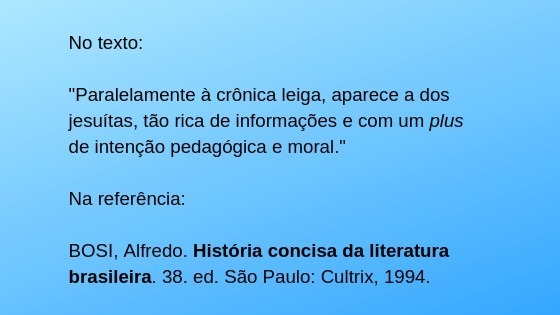Textual typologies are the types of texts created in certain contexts and that will depend on people's intention and need for communication.
The textual typology is divided into five types of texts:
- narrative typology (narration): tell a story including time, space and characters involved.
- descriptive typology (description): describe a person, an object, a place, an event.
- essay typology (dissertation): defending an idea and expressing an opinion through arguments.
- expository typology (exposure): to present a concept, an idea, or inform about something.
- injunctive typology (injunction): teaching or instructing about something with the aim of bringing about an action.
Narrative typology (narrative)
THE narration it means telling a story, events and actions of characters within a specific space and time.
Through a plot (story) the events and actions are reported by a narrator in a linear or non-linear way.
So, if the plot follows a chronological sequence, it is a linear plot. Otherwise, if there is a mixture between past, present and future, we are faced with a non-linear plot.
For ease of understanding, we can summarize the narrative elements this way:
What? - reveals the story, the central subject of the plot.
Who? - are the characters involved in the plot and can be main (protagonists) and secondary (supporting characters).
When? - indicates the moment when the story takes place.
At where? - represents the place (space) where the narrative takes place, which can be physical or psychological environments.
By whom? - the one who tells the story is the narrator (narrative focus). He can be part of the story (character narrator) or not participate in it (observant narrator or omniscient narrator).
Characteristics of narrative typology
- reveals the sequence of events in a story;
- the facts and actions are reported by a narrator (narrative focus) who participates or not in the plot;
- presence of main characters (protagonists), who appear more frequently and are more important in the story, and secondary characters (supporting characters);
- time stamping (chronological time) through historical dates and moments, or the individual time of each character (psychological time);
- indication of the place where the story is developed and that can be physical (real or imaginary) or psychological (in the characters' minds).
Examples of texts of narrative typology
The main examples of narrative texts are:
- chronicles
- Tales
- Affairs
- fables
- soap operas
These types of narration contain all the elements of the narrative: a plot told by someone (narrator), a defined space and time, in addition to including characters in the plot.
Learn more about narrative text.
Descriptive typology (description)
THE description represents the act of describing something and it can be a person, an object, a landscape, a place.
When we use descriptive typology, we seek to present the main characteristics of something, and this can be done in two ways: objective description and subjective description.
In objective description there is no value judgment, opinion, or even subjective impressions about what is being observed. Impartiality (neutral view) is one of the main characteristics of this type of description. It seeks to point out in a very realistic and believable way the attributes of something (high, low, light, dark, long, short).
In the subjective description, on the other hand, the opinion, appreciations and emotions of the person describing it appear very clearly, which can arise through the use of many adjectives. In this case, the objective is to value the form of the text in order to influence readers through a value judgment about what is being observed.
See below for examples of objective and subjective descriptions:
objective description: The Basilica of San Marco, located in Venice, is full of mosaics. (there is no opinion on what is being observed)
subjective description: A gorgeous St. Mark's Basilica, located in Venice, is filled with beautiful mosaics. (through the use of adjectives, the author's impressions are noted)
Understand more about the objective and subjective description.
Characteristics of descriptive typology
- points out the main attributes and aspects of something;
- performs a verbal portrait about something;
- values the details, the details and the minutiae;
- uses many adjectives to detail the object described;
- uses linking verbs (to be, to be, to appear) to demonstrate the object described;
- presence of verbs in the past tense and in the present tense to describe scenes;
- it resorts to metaphors and comparisons that allow a better mental image of what is being described.
Examples of descriptive texts
The main examples of descriptive texts are:
- instruction manuals
- sketches
- daily
- News
- biographies
All of them are descriptive texts, in which there is a verbal portrait made by the author (sender).
Read more about the descriptive text.
Dissertation typology (dissertation)
The dissertation is, in general, an opinionated and argumentative textual type. Furthermore, it can be persuasive, as it is intended to defend an idea or a concept on a given subject through arguments based on data, statistics and concrete examples.
Authors who use this textual typology intend to convince their readers based on their opinions and value judgments based on research they carried out or on knowledge they have about the theme.
It is noteworthy that the opinion must be presented in the third person plural (we, them) and not in the first person singular (I).
Although most of the dissertation texts are argumentative, there is also another subcategory called dissertation-expository texts. In this case, the ideas, conclusions and concepts presented are presented in a neutral and impartial manner, without the author taking a stand showing his opinion.
Understand more about the essay-argumentative text.
Characteristics of the dissertation typology
- texts written in the third person plural (we, they);
- presence of assessments, opinions and value judgments of the author of the text;
- focus on forming the reader's opinion, persuading him;
- use of the cultured norm (formal language);
- uses coherence and cohesion to create a logical and well-connected argumentation through cohesive elements;
- using data, examples, and statistics from other surveys to support your ideas;
- explanations based on other authors, for example, to defend the theme more properly.
Examples of texts of the dissertation typology
The main examples of dissertation texts are:
- articles
- monographs
- reviews
- essay
- editorials
All of them are written in a formal language and are intended to present (dissertation-expository texts) or defend an idea on a certain subject, convincing the reader (texts essays-argumentatives).
Learn more about essay text.
Expository typology (exhibition)
The exhibition is a textual type that presents information about a certain subject. Unlike argumentative texts, which use opinions and value judgments to defend an idea, this typology focuses on gathering information and presenting it in a coherent and impartial manner, without opinions that convince the reader.
This textual type can be produced in two ways: textually (through a text) or orally (through speech).
For a better understanding, let's think about the school's seminar in which the two types of expository typology are used (written and oral). The presentation projected in PowerPoint is a written expository text, and the explanation of the topic by the students is made through people's speech, configuring an oral expository text.
Learn more about informative text.
Characteristics of the expository typology
- written or oral texts without author opinions;
- use of clear and direct language;
- informative and objective textual productions, without value judgment;
- use of information, data and references to expose the topic;
- uses conceptualization and definition to explain the themes;
- uses comparisons and enumerations to facilitate understanding.
Examples of texts of the expository typology
The main examples of expository texts are:
- speeches
- interviews
- seminars
- dictionary entries
- encyclopedic entries
All of them present objective information, that is, free from subjectivities and double interpretations.
Read more about the expository text.
Injunctive typology (injunction)
An injunction is a textual type that intends to instruct or teach someone to do something, so, presents a succession of information that can be organized in small paragraphs or numbered. in steps. The central idea is to lead to an action by the receiver (or reader) who receives the message.
These texts need to be clear and objective so as not to generate doubts or double interpretations in those who are reading them. Think, for example, of an instruction manual for a piece of furniture. The objective is to indicate a step by step of everything that should be done, how it should be done and what tools will be needed to carry out this task.
Characteristics of the injunctive typology
- aim to instruct or teach someone something;
- focus on explanation and method for accomplishing something;
- objective texts, with no space for other interpretations;
- use of simple and objective language, and sometimes technical;
- presence of formal language, based on the cultured norm;
- use of imperative verbs, which denote order.
Examples of texts of the injunctive typology
The main examples of injunctive texts are:
- advertisements
- instruction manuals
- medicine inserts
- cooking recipes
- regulations
The great similarity between them is that they all offer instructions, giving information and indications about some procedure.
Understand more about the injunctive text.
Difference between textual typology and textual genres
Textual typologies are oral or written texts that have a fixed structure and well objectives. defined: reporting an event, describing a person, defending or presenting an idea, teaching the do something. They are classified into five types: narration, description, dissertation, exposition and injunction.
Textual genres, on the other hand, are more specific oral or written texts determined by the communicative intention and the context in which they are used. Considering the main characteristics and structure of the existing typologies, they arise from the five types of text.
- Examples of narrative text genres: novel, account and novel.
- Examples of descriptive text genres: biography, menu and news.
- Examples of textual text genres: monograph, article and review.
- Examples of expository text genres: seminar, lecture and interview.
- Examples of injunctive textual genres: recipes, advertisements and manuals.
To better understand this differentiation, see a example:
Nut Cake Recipe
Ingredients:
3 cups of wheat flour
1 cup of oil
1/5 cup of milk
3 eggs
1 teaspoon of yeast
1 cup of chopped walnutsHow to prepare: blend all ingredients in a blender for 3 minutes at maximum speed. Grease a rectangular pan with butter and flour, and bake in a heated oven at 180º for 30 minutes.
According to the example above, we have:
- Textual typology used: injunction
- Textual genre used: cooking recipe
Keep studying on this topic:
- Types of texts
- Textual genres
- Exercises on textual genres


